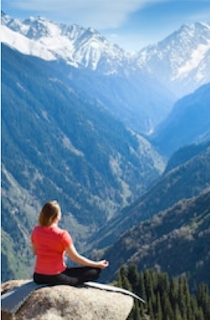Happy New Year! Welcome to the new decade.
So you signed up for the online classes, you began with excitement and vigour, but maybe your commitment has started to wane and you're not showing up as much as you had hoped you would.
Here are a few tips I'd like to share with you from my years of experience of attending classes and teaching them to help you get the most from your online practice.
1. Don't stop at the first hurdle.
If you’re just getting started on your yoga journey, you might find that the first class you attended went right over your head and you didn't fully understand it or you didn't particularly enjoy it. Don’t be put off if. When we start something totally new, we either love it straight away or we don't like the unfamiliar.
Yoga classes can be very different to other exercise classes. It's a much deeper and spiritual practice which moves the body and creates space in the muscles, joints and mind to lead to more harmonious health.
Don’t give up—keep trying and if you need guidance on which classes from the online library are suitable for you, just send me an email and I'll point you in the right direction.
2. Feel the fear and do it anyway.
Sometimes people are surprised at how challenging yoga can be, physically or mentally or both. It can seem a struggle to understand the terminology or keep up.
That's why these online classes are so great. You can pause, rewind and even speed up the classes and each video has modification options so you can pick the level you wish to practice at.
If you feel overwhelmed, simply get in touch with me and I'll guide you through the early weeks until you feel confident.
3. Show up… even when you don’t feel like it.
The online yoga classes are fantastic! You can practice whenever you like, wherever you like and wear whatever you like! You're on your own timetable with total freedom.
However, the other side of that means that you need to show up. Just as you put your yoga pants on and show up to a group class, you need to do the same with the online classes.
Of course, you should always listen to your body, but the saying, ‘You’re only one yoga class away from a good mood’ is so true.
There are days that I really can't be bothered even rolling out my mat, but in 20 years of practicing yoga, I've never finished my practice and thought - "I wish I hadn't done that". NEVER.
So show up. Show up for you.
There's a saying - "Success is Scheduled" and by gum, isn't it just?! Schedule a day and time each week when you are going to do your practice. I plan my week every Sunday evening. I plan what yoga practice I'm going to do and when I'm going to do it and how long it's going to be. I also plan what meals we're going to eat and when I'm seeing family and friends etc. If I don't do this, I don't have a clear focus for the week.
If you find that you can't take part in the online classes at the time you've scheduled, then schedule it for the next time you can. Remember, as long as you've got a phone and an internet connection, you can access my online classes.
If you would like me to put together a recommended program of classes for you, then just send me an email and I will put something together for you.
Also, be sure to ask your body what it needs, if you need something more gentle, then do a more gentle practice, if you need to lift your energy levels then do a vitality class, but show up, and it will be worth it.
Also, be sure to ask your body what it needs, if you need something more gentle, then do a more gentle practice, if you need to lift your energy levels then do a vitality class, but show up, and it will be worth it.
4. Watch, listen and observe.
Please do watch and listen to the instructions given in the video classes. When I talk about alignment - check your body placement, when I mention the breath - check your breathing, when I mention bandhas and core strength - check you've got those muscles working. Always check, even if you’ve done that particular pose or sequence a million, trillion times. LISTEN and OBSERVE your body.
5. Have a mirror nearby.
It’s helpful to do your practice in front of a mirror, not to check your hair or judge yourself but as a way to observe how your body moves, the alignment of your body, your posture and awareness of how you feel when your body is positioned a certain way.
This a wonderful tool. You will start to notice how you feel when you're in correct alignment and then when you take your yoga off the mat and move in every day life, you'll know if your posture is correct because you will FEEL that it is!
6. Don’t miss the gentler yoga classes.
Every yoga class has a gift in it. If you like the stronger, more dynamic classes then give the gentler ones a try too. Keep your mind open.
Gentler yoga classes give your body and mind a chance to relax and rest a little more. This allows deep healing to take place in the body. It's a way to destress and unwind on a slower level.
In Ayurveda, we teach that health is a balancing act. Balancing all the elements within us, constantly. If you always go for the same classes you're not giving yourself the chance to balance the elements within. Balance the fiery, energetic classes with more earthy, soft flowing classes.
7. Yoga is not a place for competition.
Yoga is not a place for competition. Try to be humble and kind to yourself in your practice. Use props, the wall, straps, chairs, blocks, if it means that your body isn't in pain or you're better aligned. Props are not a sign of weakness, they aid you in your experience of a pose - enabling your back to be straighter or your balance to be steadier.
Please be patient with yourself. Yoga is neither a competition nor a race.
I've been asked - "how long will it take me to touch my toes?", "When do you think I'll have mastered hanumanasana?", "When will I know all the names of the poses?"
The answer is always the same. There is no time frame. Enjoy, learn and focus on the journey rather than the destination.
8. Stay for Savasana.
The final relaxation pose, Savasana, is one of the most important poses you’ll do during your practice. Try not to be tempted to switch off the video before the end. Give yourself the time to experience why Savasana is so important and beneficial for you, even if you find it hard to stay focused and still. Keep an open mind and keep trying.
In time, you'll find that this is one of the reasons why you'll want to do your practice!
Savasana, even though it looks easy, is said to be the hardest pose in a yoga class. The art of relaxing does not happen under demand. That's why Savasana is such a beautiful experience. The pose and Yoga Nidra (the relaxation process, literally means - yoga sleep) sets you up to gradually enter a truly relaxed state, one that is incredibly refreshing and can also be a starting point for meditation.
When you first start lie in Savasana, it can be a struggle to relax; you may feel tense or silly or need to fidget or unable to switch off. Or, conversly, you might fall asleep as soon as you you lie down. Savasana is the process of relaxing whilst remaining conscious and alert and at ease.
In Savasana you isolate and relax one part of your body at a time, one muscle at a time, one breath at a time and one thought at a time. When you do this practice regularly, your body automatically begins to release stress which can improve your overall physical and emotional well-being.
If you feel uncomfortable lying down then use cushions to make you feel better. Pop cushions under your knees to improve circulation and release tension in the back muscles. Or put cushions under your back and head, to open your chest and release the shoulders. Or relax in a chair if that feels better for you. Just don't miss it out.
These aren’t the only ways to get the most from your online yoga classes, but they will help you along the way.
Committing to regularly rolling out your mat and watching the classes can sometimes feel like another thing to get done on your list, but embrace this time for you, your sacred space. Feel the energy you gain and the joy.
I'll see you on the mat.
by Jenny Dowling - Jenny is passionate about yoga and yoga health. Her love of yoga began at the age of 11 when she was introduced to it by her mother. When Jenny isn't teaching or recording classes for her online yoga members, she is busy looking after her little family (daughter, fiancé and Finnish Lapphund), walking in the nearby moorland or trying out new delicious Ayurvedic and vegan recipes. Connect with Jenny on Facebook or Instagram.














